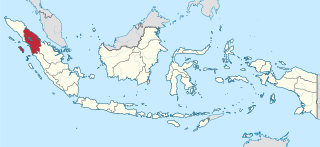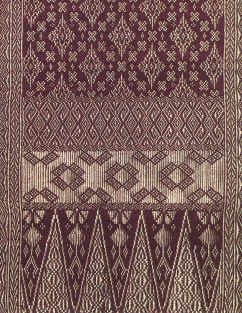
Palembang is the capital city of the Indonesian province of South Sumatra. The city proper covers 352.51 square kilometres on both banks of the Musi River in the eastern lowlands of southern Sumatra. It had a population of 1,668,848 at the 2020 Census; the official estimate as at mid 2023 was 1,772,492. Palembang is the second most populous city in Sumatra, after Medan, and the twelfth most populous city in Indonesia.

North Sumatra, also called North Sumatra Province, is a province of Indonesia located in the northern part of the island of Sumatra, just south of Aceh. Its capital and largest city is Medan on the east coast of the island. It is bordered by Aceh on the northwest and Riau and West Sumatra on the southeast, by coastlines located on the Indian Ocean to the west, and by the Strait of Malacca to the east.

South Sumatra is a province of Indonesia, located in the southeast of the island of Sumatra. The capital and largest city of the province is the city of Palembang. The province borders the provinces of Jambi to the north, Bengkulu to the west and Lampung to the south, as well a maritime border with the Bangka Belitung Islands to the east. It is the largest province in the island of Sumatra, and it is slightly smaller than Portugal, the department of Boquerón in Paraguay or the U.S. state of Maine. The Bangka Strait in the east separates South Sumatra and the island of Bangka, which is part of the Bangka Belitung Islands province. The province has an area of 91,592.43 km2 (35,364 sq mi) and had a population of 8,467,432 at the 2020 census; the official estimate as at mid-2023 was 8,743,522. The province is rich in natural resources, such as petroleum, natural gas and coal. The province is inhabited by many different Malay sub ethnic groups, with Palembangese being largest ethnic group. Most speak the Palembang language, which is mutually intelligible to both Indonesian and local Palembang Malay. Other ethnic groups include the Javanese, Sundanese, Minangkabau and Chinese. Most are concentrated in urban areas and are largely immigrants from other parts of Indonesia.

The culture of Indonesia has been shaped by the interplay of indigenous customs and diverse foreign influences. With over 1,300 distinct ethnic groups, including significant Austronesian and Melanesian cultures, contributing to its rich traditions, languages, and customs, Indonesia is a melting pot of diversity. Positioned along ancient trade routes between the Far East, South Asia, and the Middle East, the country has absorbed cultural practices influenced by Hinduism, Buddhism, Confucianism, Islam, and Christianity. These influences have created a complex cultural tapestry that often differs from the original indigenous cultures.

Batak is a collective term used to identify a number of closely related Austronesian ethnic groups predominantly found in North Sumatra, Indonesia, who speak Batak languages. The term is used to include the Karo, Pakpak, Simalungun, Toba, Angkola, Mandailing and related ethnic groups with distinct languages and traditional customs (adat).

Rumah Gadang or Rumah Bagonjong "house for the Minangkabau people" are the traditional homes of the Minangkabau in West Sumatra, Indonesia. The architecture, construction, internal and external decoration, and the functions of the house reflect the culture and values of the Minangkabau. A Rumah Gadang serves as a residence, a hall for family meetings, and for ceremonial activities. In the matrilineal Minangkabau society, the Rumah Gadang is owned by the women of the family who live there; ownership is passed from mother to daughter.

Singa is an apotropaic figure from the mythology of the Batak people of North Sumatra, Indonesia. The singa represents a benevolent and protective power. The singa is described as "part human, part water buffalo, and part crocodile or lizard". It is variedly represented, but always has an elongated face, with big bulging eyes, a well-defined nose, and long spiraling beard. It is often represented only with its head, but sometimes it may also be represented full body. Other figures - such as other protective deity or ancestral figures - may also be represented standing or sitting on top of the head of the singa.

Songket or sungkit is a tenun fabric that belongs to the brocade family of textiles of Brunei, Indonesia, and Malaysia. It is hand-woven in silk or cotton, and intricately patterned with gold or silver threads. The metallic threads stand out against the background cloth to create a shimmering effect. In the weaving process the metallic threads are inserted in between the silk or cotton weft (latitudinal) threads in a technique called supplementary weft weaving technique.

The architecture of Indonesia reflects the diversity of cultural, historical, and geographic influences that have shaped Indonesia as a whole. Invaders, colonizers, missionaries, merchants, and traders brought cultural changes that had a profound effect on building styles and techniques.

A candi is a Hindu or Buddhist temple in Indonesia, mostly built during the Zaman Hindu-Buddha or "Hindu-Buddhist period" between circa the 4th and 15th centuries.

Christianity is Indonesia's second-largest religion, after Islam. Indonesia also has the second-largest Christian population in Southeast Asia after the Philippines, the largest Protestant population in Southeast Asia, and the third-largest Christian population in Asia after the Philippines and China. Indonesia also has the second-largest Christian population in the Muslim world, after Nigeria, followed by Egypt. Indonesia's 29.4 million Christians constituted 10.47% of the country's population in 2023, with 7.41% Protestant and 3.06% Catholic. Some provinces in Indonesia are majority Christian. In Indonesia, the word Kristen refers to Protestantism, while Catholicism is referred to as Katolik. In the 21st century the rate of growth and spread of Christianity has increased, especially among the Chinese minority.

The Toba Batak people are the largest ethnic group of the Batak peoples of North Sumatra, Indonesia. The general term ‘Batak’ is sometimes used to refer to the Batak Toba people, for one thing because the Toba people are the largest sub-group of the Batak ethnicity, for another because they tend to self-identify as merely Batak instead of ‘Toba’ or ‘Batak Toba’, contrary to the habit of the Karo, Mandailing, Simalungun, Pakpak communities who commonly self-identify with their respective sub-groups.

Batak architecture refers to the related architectural traditions and designs of the various Batak peoples of North Sumatra, Indonesia. Six groups of Batak speak separate but related languages: the Angkola, the Mandailing to the south, the Toba, to the north the Pakpak/Dairi, the Simalungun, and the Karo. While the groups are now Muslim or Christian, elements of the ancient Batak religion remain, particularly amongst the Karo.

Rumah adat are traditional houses built in any of the vernacular architecture styles of Indonesia, collectively belonging to the Austronesian architecture. The traditional houses and settlements of the several hundreds ethnic groups of Indonesia are extremely varied and all have their own specific history. It is the Indonesian variants of the whole Austronesian architecture found all over places where Austronesian people inhabited from the Pacific to Madagascar each having their own history, culture and style.

Boraspati ni Tano or Boraspati, also known as Ilik, is the earth deity in Batak mythology. Boraspati ni Tano is represented as a tokay gecko. Images of Boraspati can be found decorating the door of a Batak Karo and Batak Toba buildings as well as other Batak objects e.g. the cover of the pustaha or the pupuk container naga morsarang.

A sopo is a treasury structure in the architecture of the Toba Batak people from North Sumatra, Indonesia. Its form is similar to that of a Batak traditional house with the exception of being smaller in size and a construction ritual that is the opposite of a Batak house. Sopo is used as a repository for various items, e.g. rice, magical items, or trophies. Sopo can also be used as a meeting point for social activities.

Pustaha is the magic book of the Batak people of North Sumatra, Indonesia. The book contains magical formulas, divinations, recipes, and laws. The pustaha is written and compiled by a Batak magician-priest (datu).

Geriten, or "head-house", is the skull-house of the Karo people of North Sumatra, Indonesia. It is a pavilion-like structure with a distinctively shaped roof that acted as an ossuary where the skulls of chiefs and important individuals were preserved after their deaths.

The naga morsarang, also known as sahan, is a container which is used to store medicine in the culture of Toba Batak people of North Sumatra, Indonesia. The naga morsarang is created out of the horn of the water buffalo.

Rumah ulu is a vernacular house found in the highlands of South Sumatra, Indonesia. The house is associated with the Uluan people, who reside in the region upstream of the Ogan and Musi rivers.




















